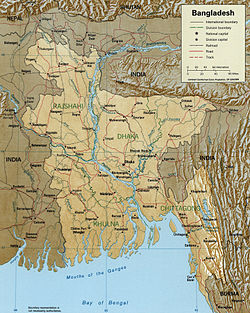Meghna River
| Meghna Lower Meghna | |
|---|---|
 | |
 | |
| Native name | মেঘনা নদী (Bengali) |
| Location | |
| Countries | Bangladesh |
| Physical characteristics | |
| Source | |
| • location | Chandpur (Confluence of Padma and Upper Meghna) |
| • coordinates | 23°13′11.1792″N 90°37′49.5708″E / 23.219772000°N 90.630436333°E |
| • elevation | 0.5 m (1 ft 8 in) |
| Mouth | |
• location | Bay of Bengal |
• coordinates | 22°0′46.7064″N 90°51′34.848″E / 22.012974000°N 90.85968000°E |
• elevation | 0 m (0 ft) |
| Length | 130 km (81 mi)[1] |
| Basin size | 1,574,223.9 km2 (607,811.2 sq mi)[1] |
| Discharge | |
| • location | Chandpur |
| • average | (Period: 1971–2000)40,532.9 m3/s (1,431,410 cu ft/s)[1] |
| • minimum | 10,000 m3/s (350,000 cu ft/s) |
| • maximum | 160,000 m3/s (5,700,000 cu ft/s) |
| Basin features | |
Ganges River | |
| Tributaries | |
| • left | Upper Meghna |
| • right | Padma |
The Meghna (

Upper Meghna
Course
The Meghna is formed by the confluence of the
| Upper Meghna (Bengali: মেঘনা নদী) Barak, Surma, Kushyiara, Kalni | |
|---|---|
 A view of the Meghna from a bridge | |
 | |
| Location | |
| Countries | Bangladesh |
| Physical characteristics | |
| Source | |
| • location | Confluence of Kalni and Ghorautra |
| • coordinates | 24°9′16.902″N 90°59′9.8376″E / 24.15469500°N 90.986066000°E |
| • elevation | 1 m (3 ft 3 in) |
| Mouth | |
• location | Chandpur |
• coordinates | 23°15′19.4112″N 90°38′41.892″E / 23.255392000°N 90.64497000°E |
• elevation | 0.5 m (1 ft 8 in) |
| Length | 140 km (87 mi) (Upper Meghna–Kalni–Kushyiara–Barak 1,040 km)[1] |
| Basin size | 85,401.1 km2 (32,973.5 sq mi)[1] |
| Discharge | |
| • location | Chandpur |
| • average | (Period: 1971–2000)5,603.2 m3/s (197,880 cu ft/s)[1] |
| Discharge | |
| • location | Bhairab Bazar |
| • average | (Period: 1984–2012)5,486 m3/s (193,700 cu ft/s)[3] |
| • maximum | 13,000 m3/s (460,000 cu ft/s)[3] |
| Basin features | |
| Progression | Meghna (Lower Meghna) → Ganges River |
| Tributaries | |
| • left | Kalni, Gumti, Titas |
| • right | Ghorautra, Old Brahmaputra, Dhaleshwari |
Near Muladhuli in Barisal district, the Safipur River is an offshoot of the Surma that creates one of the main rivers in South Bengal. 1.5 km wide, this river is one of the widest in the country as well.[citation needed]
At Chatalpar of Brahmanbaria District, the river Titas emerges from Meghna and after circling two large bends by a distance of about 240 kilometres (150 mi) [citation needed], falls into the Meghna again near Nabinagar Upazila. The Titas forms as a single stream but braids into two distinct streams that remain separate before re-joining the Meghna.
In Daudkandi, (Comilla District), the Meghna is joined by the Gumti River, which increases the Meghna water flow considerably. The pair of bridges over the Meghna and Gumti are two of the country's largest bridges.
The Meghna is reinforced by the
After Chandpur, the combined flow of the Padma, Jamuna, and Meghna moves down to the Bay of Bengal in an almost straight line, braiding occasionally into a number of riverines including the Pagli, Katalia, Dhonagoda, Matlab, and Udhamodi. All of these rivers rejoin the Meghna at different points downstream.[citation needed]
Near Bhola, just before flowing into the Bay of Bengal, the river again divides into two main streams in the Ganges delta and separates an island from both sides of the mainland. The western stream is called Ilsha while the eastern one is called Bamni. They form the largest delta in the world named the Ganges Delta.[citation needed]
See also
- List of rivers in Bangladesh
References
- ^ a b c d e f "Ganga (Ganges)-Brahmaputra".
- ^ Masud Hasan Chowdhury (2012). "Meghna River". In Sirajul Islam and Ahmed A. Jamal (ed.). Banglapedia: National Encyclopedia of Bangladesh (Second ed.). Asiatic Society of Bangladesh. Retrieved 27 February 2020.
- ^ .
